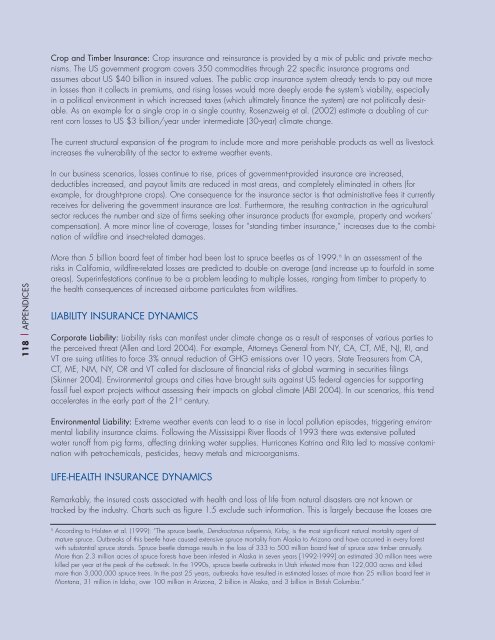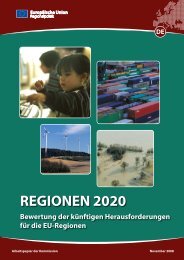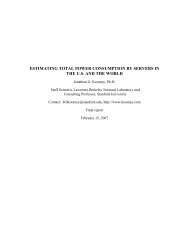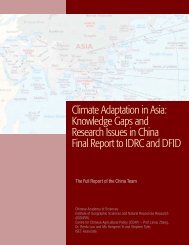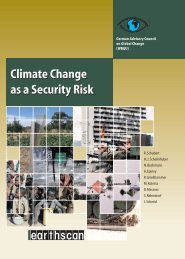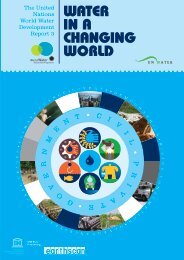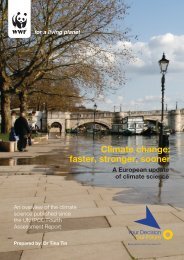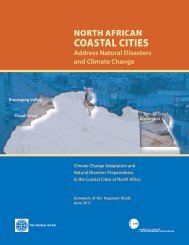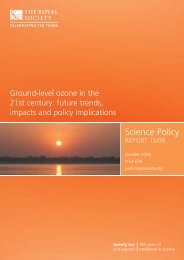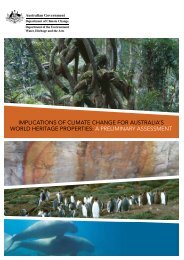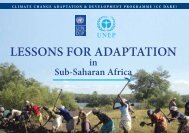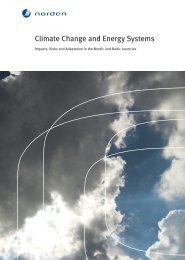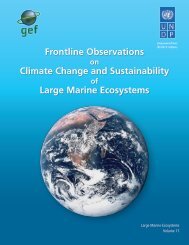<strong>Climate</strong> sensitivity for small-scale events can be quite high. For example, for every increase in average temperaturesof 1°C we expect a 70% increase in air-to-ground lightning strikes (Reeve <strong>and</strong> Toumi 1999).Personal Automobile Insurance: The impact of catastrophes on automobile losses began to become visible duringthe 1980s <strong>and</strong> 1990s, but these understate the true extent of the losses because only those losses from catastrophicevents were tabulated in association with inclement weather. As the incidence of small storms increases,roadway conditions can erode <strong>and</strong> there are more days with low visibility, icy conditions, <strong>and</strong> precipitation,resulting in a steady increase of accidents.Energy <strong>and</strong> Water Utility Systems: Increasingly extensive <strong>and</strong> interconnected energy <strong>and</strong> other systemsenhance the quality of life, but also increase society’s vulnerability to natural hazards (Sullivan 2003). Energy systemsare already experiencing rising losses. Under accelerated, non-linear climate <strong>change</strong>, there are increaseddamages to energy <strong>and</strong> water industry infrastructure, including ruptured oil <strong>and</strong> electricity transmission systems dueto widespread permafrost melt throughout the northern latitudes, <strong>and</strong> risks to power plants. Increased extremeweather events, such as ice storms <strong>and</strong> heat catastrophes, cause increased numbers of blackouts <strong>and</strong> water contaminationor direct damages to water plants.The following are several examples of the nature of energy system sensitivities to extreme weather events(Munich Re 2003):• The US northeast Ice Storm of 1998 was the most expensive disaster in the history of the Canadianinsurance industry.• In 1998, on the other side of the world in Auckl<strong>and</strong>, New Zeal<strong>and</strong>, the most severe heat wave since 1868caused spikes in air-conditioning power dem<strong>and</strong> <strong>and</strong> the overloading <strong>and</strong> subsequent collapse of two electricitytransmission cable lines.• In 1999, a flash of lightning plunged more than 80 million people in Sao Paulo <strong>and</strong> Rio de Janeiro, <strong>and</strong> eightother Brazilian states into darkness. Two years later, a prolonged drought — the worst in 70 years — led to anational power crisis, with rationing lasting nearly nine months.• In 1999, the great windstorms caused EU2.5 billion in damages to France’s largest electricity supplier.• In 1982, a shortage of rain forced deep load shedding in Ghana. Impacts included business interruptions ofUS $557 million at an aluminum smelter.• In 1993, the Des Moines Water Works was shut down due to flooding. Direct property damages <strong>and</strong> emergencymeasures were US $16 million, but the indirect business interruption losses resulted in 250,000 commercial<strong>and</strong> residential customers being without water for 11 days.117 | APPENDICESA particularly diverse set of risks apply in the electricity sector (Mills 2001). The current US baseline cost of electricaloutages of US $80 billion per year (LaCommare <strong>and</strong> Eto 2004) could double under our scenarios. In our scenarios,businesses seek increasing business-interruption coverage for such events, <strong>and</strong> a larger share of consequentlosses is paid by insurers. In addition, increasingly frequent drought conditions result in power curtailmentsthat cause further business interruptions in regions heavily dependent on hydroelectric power. Drought plus unacceptablyhigher cooling water temperatures in summer 2003 forced curtailments or closures of nuclear <strong>and</strong> otherthermal plants in France, Germany, Romania <strong>and</strong> Croatia <strong>and</strong> price spikes in addition (Reuters 2003, Guardian2003). Massive oil-sector losses such as those caused by Hurricane Ivan (approximately US $2.5 billion, well inexcess of the year’s entire premium revenue for the sector) 5 (Miller 2004), would become more common.Premiums for vulnerable oil infrastructure were projected to double after this event, <strong>and</strong> consumers faced higherprices due to the 500,000 barrel per day supply shortfall (The Energy Daily 2004a). Emblematic of the industry’shistory of underestimating its exposures, a representative of Hiscox Syndicates in London stated that “the markethas had a much worse loss than ever anticipated.” Electric utilities were also hard hit, with one utility’s costs reachingUS $252 million (The Energy Daily 2004b).5Hurricane Ivan destroyed seven oil platforms, damaged six others as well as five drilling platforms, <strong>and</strong> pipelines were buried by underwatermudslides in the Mississippi Delta. In Hurricanes Katrina <strong>and</strong> Rita, 109 off-shore oil rigs were destroyed <strong>and</strong> 31 severly damaged.
Crop <strong>and</strong> Timber Insurance: Crop insurance <strong>and</strong> reinsurance is provided by a mix of public <strong>and</strong> private mechanisms.The US government program covers 350 commodities through 22 specific insurance programs <strong>and</strong>assumes about US $40 billion in insured values. The public crop insurance system already tends to pay out morein losses than it collects in premiums, <strong>and</strong> rising losses would more deeply erode the system’s viability, especiallyin a political environment in which increased taxes (which ultimately finance the system) are not politically desirable.As an example for a single crop in a single country, Rosenzweig et al. (2002) estimate a doubling of currentcorn losses to US $3 billion/year under intermediate (30-year) climate <strong>change</strong>.The current structural expansion of the program to include more <strong>and</strong> more perishable products as well as livestockincreases the vulnerability of the sector to extreme weather events.In our business scenarios, losses continue to rise, prices of government-provided insurance are increased,deductibles increased, <strong>and</strong> payout limits are reduced in most areas, <strong>and</strong> completely eliminated in others (forexample, for drought-prone crops). One consequence for the insurance sector is that administrative fees it currentlyreceives for delivering the government insurance are lost. Furthermore, the resulting contraction in the agriculturalsector reduces the number <strong>and</strong> size of firms seeking other insurance products (for example, property <strong>and</strong> workers’compensation). A more minor line of coverage, losses for “st<strong>and</strong>ing timber insurance,” increases due to the combinationof wildfire <strong>and</strong> insect-related damages.118 | APPENDICESMore than 5 billion board feet of timber had been lost to spruce beetles as of 1999. 6 In an assessment of therisks in California, wildfire-related losses are predicted to double on average (<strong>and</strong> increase up to fourfold in someareas). Superinfestations continue to be a problem leading to multiple losses, ranging from timber to property tothe <strong>health</strong> consequences of increased airborne particulates from wildfires.LIABILITY INSURANCE DYNAMICSCorporate Liability: Liability risks can manifest under climate <strong>change</strong> as a result of responses of various parties tothe perceived threat (Allen <strong>and</strong> Lord 2004). For example, Attorneys General from NY, CA, CT, ME, NJ, RI, <strong>and</strong>VT are suing utilities to force 3% annual reduction of GHG emissions over 10 years. State Treasurers from CA,CT, ME, NM, NY, OR <strong>and</strong> VT called for disclosure of financial risks of global warming in securities filings(Skinner 2004). Environmental groups <strong>and</strong> cities have brought suits against US federal agencies for supportingfossil fuel export projects without assessing their impacts on global climate (ABI 2004). In our scenarios, this trendaccelerates in the early part of the 21 st century.Environmental Liability: Extreme weather events can lead to a rise in local pollution episodes, triggering environmentalliability insurance claims. Following the Mississippi River floods of 1993 there was extensive pollutedwater runoff from pig farms, affecting drinking water supplies. Hurricanes Katrina <strong>and</strong> Rita led to massive contaminationwith petrochemicals, pesticides, heavy metals <strong>and</strong> microorganisms.LIFE-HEALTH INSURANCE DYNAMICSRemarkably, the insured costs associated with <strong>health</strong> <strong>and</strong> loss of life from natural disasters are not known ortracked by the industry. Charts such as figure 1.5 exclude such information. This is largely because the losses are6According to Holsten et al. (1999): “The spruce beetle, Dendroctonus rufipennis, Kirby, is the most significant natural mortality agent ofmature spruce. Outbreaks of this beetle have caused extensive spruce mortality from Alaska to Arizona <strong>and</strong> have occurred in every forestwith substantial spruce st<strong>and</strong>s. Spruce beetle damage results in the loss of 333 to 500 million board feet of spruce saw timber annually.More than 2.3 million acres of spruce forests have been infested in Alaska in seven years [1992-1999] an estimated 30 million trees werekilled per year at the peak of the outbreak. In the 1990s, spruce beetle outbreaks in Utah infested more than 122,000 acres <strong>and</strong> killedmore than 3,000,000 spruce trees. In the past 25 years, outbreaks have resulted in estimated losses of more than 25 million board feet inMontana, 31 million in Idaho, over 100 million in Arizona, 2 billion in Alaska, <strong>and</strong> 3 billion in British Columbia.”
- Page 1 and 2:
Climate Change FuturesHealth, Ecolo
- Page 4 and 5:
Table of ContentsIntroductionPart I
- Page 6 and 7:
EXECUTIVE SUMMARYClimate is the con
- Page 8 and 9:
the past decade, an increasing prop
- Page 10 and 11:
THE CASE STUDIES IN BRIEFInfectious
- Page 12 and 13:
THE INSURER’S OVERVIEW:A UNIQUE P
- Page 14:
Regulators and governments can empl
- Page 17 and 18:
THE PROBLEM:CLIMATE IS CHANGING, FA
- Page 19 and 20:
Figure 1.3 GreenlandEXTREMESOne of
- Page 21 and 22:
20 | THE CLIMATE CONTEXT TODAYWholl
- Page 23 and 24:
Figure 1.5 Global Weather-Related L
- Page 25 and 26:
Climate signals in rising costs fro
- Page 27 and 28:
CLIMATE CHANGE CANOCCUR ABRUPTLYPer
- Page 29 and 30:
28 | THE CLIMATE CONTEXT TODAYCCF-I
- Page 31 and 32:
communities, salinizing ground wate
- Page 33 and 34:
Health is the final common pathway
- Page 35 and 36:
34 | INFECTIOUS AND RESPIRATORY DIS
- Page 37 and 38:
Figure 2.4 Malaria and Floods in Mo
- Page 39 and 40:
Figure 2.61920-1980CASE STUDIES38 |
- Page 41 and 42:
A MALARIA SUCCESSThe New York Times
- Page 43 and 44:
A new flavivirus, Usutu, akin to WN
- Page 45 and 46:
44 | INFECTIOUS AND RESPIRATORY DIS
- Page 47 and 48:
One analysis (Vanderhoof and Vander
- Page 49 and 50:
BIODIVERSITYBUFFERS AGAINSTTHE SPRE
- Page 51 and 52:
Figure 2.15 RagweedMOLDSLong-term f
- Page 53 and 54:
ASTHMA COSTSTODAYexamples, the Afri
- Page 55 and 56:
Stott et al. (2004) calculate that
- Page 57 and 58:
In the summer of 2005, northern Spa
- Page 59 and 60:
a better understanding of subpopula
- Page 61 and 62:
60 | EXTREME WEATHER EVENTSFLOODSFO
- Page 63 and 64:
MOSQUITO- AND SOIL-BORNE DISEASESEC
- Page 65 and 66:
Table 2.2 Direct and Indirect Healt
- Page 67 and 68: HEALTH AND ECOLOGICALIMPLICATIONSOu
- Page 69 and 70: 68 | NATURAL AND MANAGED SYSTEMSCAS
- Page 71 and 72: Figure 2.27 Soybean Sudden Death Sy
- Page 73 and 74: 72 | NATURAL AND MANAGED SYSTEMSCAS
- Page 75 and 76: 74 | NATURAL AND MANAGED SYSTEMSCAS
- Page 77 and 78: 76 | NATURAL AND MANAGED SYSTEMSCAS
- Page 79 and 80: 78 | NATURAL AND MANAGED SYSTEMSTHE
- Page 81 and 82: HARMFUL ALGALBLOOMSFigure 2.32 Red
- Page 83 and 84: 82 | NATURAL AND MANAGED SYSTEMSCAS
- Page 85 and 86: CASE STUDIES 84 | NATURAL AND MANAG
- Page 87 and 88: CASE STUDIES 86 | NATURAL AND MANAG
- Page 89 and 90: CASE STUDIES 88 | NATURAL AND MANAG
- Page 91 and 92: CASE STUDIES 90 | NATURAL AND MANAG
- Page 93 and 94: “Climate change is one of the wor
- Page 95 and 96: 94 | FINANCIAL IMPLICATIONS• Incr
- Page 97 and 98: Extreme weather events are a partic
- Page 99 and 100: 98 | FINANCIAL IMPLICATIONSTable 3.
- Page 101 and 102: 100 | FINANCIAL IMPLICATIONSdemand
- Page 103 and 104: 102 | FINANCIAL IMPLICATIONSClimate
- Page 105 and 106: These include:Solar Photovoltaic Pa
- Page 107 and 108: • Social and economic factors in
- Page 109 and 110: Finally, new technologies need to b
- Page 111 and 112: 110 | FINANCIAL IMPLICATIONSBRETTON
- Page 113: 112 | APPENDICESAppendix A. Summary
- Page 116 and 117: Table B.1 Summer Percentage Frequen
- Page 120 and 121: diffuse and do not manifest in sing
- Page 122 and 123: APPENDIX D.LIST OF PARTICIPANTS ATT
- Page 124: Carmenza RobledoGruppe OekologieEMP
- Page 127 and 128: 126 | BIBLIOGRAPHYBibliographyAAAAI
- Page 129 and 130: 128 | BIBLIOGRAPHYChordas, L. Epide
- Page 131 and 132: Ford, S.E. & Tripp, M.R. Diseases a
- Page 133 and 134: 132 | BIBLIOGRAPHYKalkstein, L. S.,
- Page 135 and 136: 134 | BIBLIOGRAPHYMills, E. The ins
- Page 137 and 138: 136 | BIBLIOGRAPHYRose, J. B., Epst
- Page 139 and 140: 138 | BIBLIOGRAPHYVandyk, J. K., Ba
- Page 142: Infectious and Respiratory Diseases


